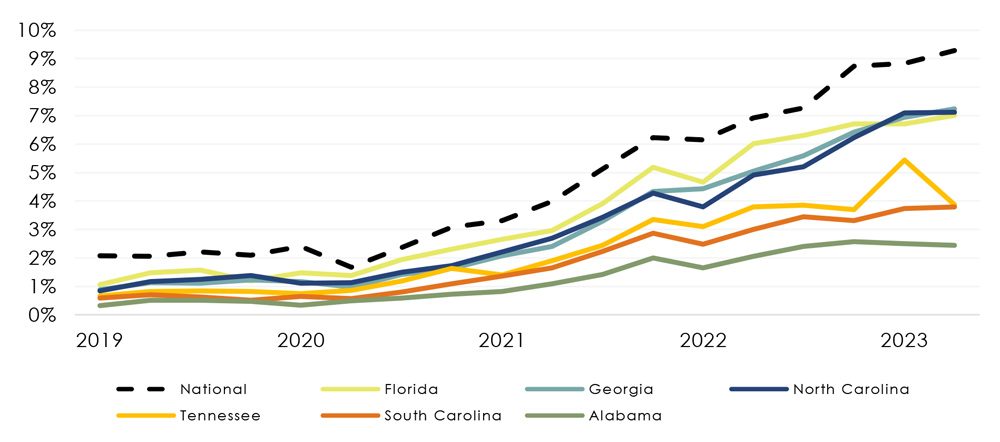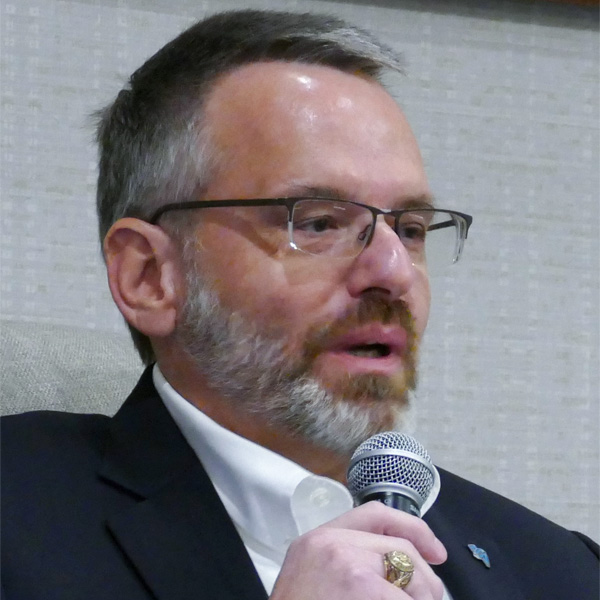MISO said it will seek approval from its board of directors for 578 transmission projects totaling $9.4 billion in December.
The RTO’s 2023 Transmission Expansion Plan (MTEP 23) makes for MISO’s largest-ever annual planning cycle and includes a substitution for two MISO South reliability projects. That’s according to MISO’s final round of subregional planning meetings for the year Sept. 5-8.
MISO South transmission owners plan to build 76 new projects at $4.3 billion, most of them to meet their own reliability planning criteria or NERC’s reliability standards. The dramatic jump in proposed spending led some stakeholders this year to allege Entergy was circumventing more comprehensive and cost-shared regional projects. (See Initial MTEP 23 Ignites Familiar Arguments over MISO South’s Reliability Spending.)
By comparison, MTEP 22 yielded a total $4.3 billion investment package. MISO’s first long-range transmission plan (LRTP) portfolio approved last year — considered separate from the annual MTEP planning — produced a $10 billion investment.
MISO this year tested alternative designs for 11 proposed projects that represented 40% of MTEP 23 spending. Planning staff previously said multiple MISO South reliability projects, particularly substation work, might benefit from substitute projects. (See MISO Weighs MTEP 23 Alternatives to South Reliability Projects.)
Now, MISO said it’s pursuing an alternative for the first phase of the three-part, nearly $2 billion Amite South line and substation work in Entergy Louisiana’s southern territory. MISO said its selected alternative, the 500-kV Commodore-Waterford-Churchill loop project, will tie the area’s 230- and 500-kV systems together at three points instead of two and better equip the system for future load growth in both the Amite South and Downstream of Gypsy load pockets in Louisiana. The extended 500-kV line will negate the need for another MTEP 23 project proposed by Entergy Louisiana, the 27-mile, 230-kV Downstream of Gypsy reliability project.
The project alternative is pricier than the original two projects combined, at $1.7 billion instead of the originally proposed $1.4 billion for Amite South Phase 1 and the $164 million for the Downstream of Gypsy project. The project involves building a new 500/230-kV substation; stringing a new 60-mile, 230-kV line and a new 85-mile, 500-kV line; upgrading an existing substation; and upgrading an existing nearby 230-kV line to 500 kV.
“So, we chose one project alternative to replace two proposed projects,” Manager of MISO South Expansion Planning Trevor Armstrong said during a Sept. 6 South Subregional Planning Meeting. “The alternative is more expensive, but it provided more load-serving opportunity for growth.”
Entergy expects 2 GW of new load across the Amite South load pocket soon.
MISO also said the larger project will improve system resilience when extreme events strike and will address coming generation retirements in Amite South by allowing the option to cut multiple sources into existing stations.
The project still will have a 100% local allocation to load. MISO South’s first regionally cost-shared, market efficiency project remains elusive.
Southern Renewable Energy Association’s Andy Kowalczyk asked if Entergy pitched the idea for the substitution.
Armstrong said the design was on Entergy’s list of alternative project suggestions, but it resembled a project idea MISO independently devised. He said the alternative ultimately was developed in conjunction with Entergy.
“This was the only one we felt needed to be selected in place of the original projects,” Armstrong said.
Kowalczyk asked whether MISO planners will develop load growth projections for its planning modeling. MISO was forced to perform a separate sensitivity outside of its usual modeling to test for alternatives because it doesn’t account for forward-looking load additions and generation retirements in modeling.
“I think they’re credible inputs that need to be considered. I think it’ll be a bit of a shock every year to have projects this size, and you have to perform a separate sensitivity,” Kowalczyk said. “Maybe we’re not accounting for future needs in the most cost-efficient way.”
MISO planners said they don’t have definite plans to include load growth estimates in planning modeling.
Armstrong said the majority of the South region’s MTEP 23 projects will be placed into service within the next three years.
Armstrong added that MISO still is working to develop possible alternatives to the third phase of Entergy Louisiana’s Amite South reliability project. He said MISO likely will delay project approval into 2024; MISO planners said they didn’t know whether the project will be included as a late addition to MTEP 23 or be deferred into the 2024 planning cycle.
However, MISO left standing the controversial $1.1 billion, 150-mile 500-kV line and substation project Entergy proposed for Southeast Texas. Planners said they couldn’t find a better alternative in terms of economics or reliability to the baseline reliability project consisting of a 150-mile, 500-kV line, 500-kV substation and 500-230-138-kV substation.
Entergy said the Southeast Texas project will help meet its local planning criteria, reduce dependence on aging and increasingly unavailable resources, and be useful when restoring the grid from extremes wrought by winter storms and hurricanes.
During the Planning Advisory Committee last week, MISO Director of Cost Allocation Jeremiah Doner said load growth and reliability issues are driving the need for more transmission investment.
Because of the size of this year’s MTEP, MISO will add another meeting of the System Planning Committee of the Board of Directors in mid-October to give MISO board members more time to understand the package’s contents.
Sustainable FERC Project’s Natalie McIntire asked MISO to revisit its definition of “other” projects because most of the spending is classed under the category this year. MISO’s other project category includes reliability projects based on TOs’ self-imposed criteria separate from NERC standards, projects needed for load growth and projects to address the age and condition of existing facilities. Other projects have become the lion’s share of MTEP spending since the 2018 cycle.
MISO is accepting stakeholder suggestions and considering what additional planning studies it may undertake as part of MTEP 24. However, planning staff warned that MISO is limited next year in what it can accomplish because it’s performing extensive analysis under its ongoing LRTP.
MISO will hold stakeholder workshops on the nascent, second LRTP portfolio again Dec. 1 and at the end of January.
MISO: Expedited Review Process Needs Revamp
Lastly, MISO said the MTEP 23 planning cycle has made it clear it should rethink its expedited project review process for projects that can’t wait until the usual December MTEP approval to begin construction. MISO said it fielded more than 30 expedited project review requests — double the number it received in 2022 — predominantly because of new load interconnections.
Armstrong said some expedited requests were “simple, while others have become quite complex.” He said MISO planning staff is struggling to complete on-time studies on the out-of-cycle requests. MISO likely will need to overhaul its expedited processing to make the ever-increasing analyses manageable, he said.
“We have seen some ones that cause harm to the system and require some back and forth. At this volume, it’s not sustainable,” Senior Manager of Expansion Planning Amanda Schiro added during a Sept. 8 East Subregional Planning Meeting.
Schiro told stakeholders MISO staff is discussing internally how to best modify its process and said stakeholders should expect a proposal in coming months.


